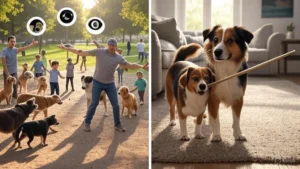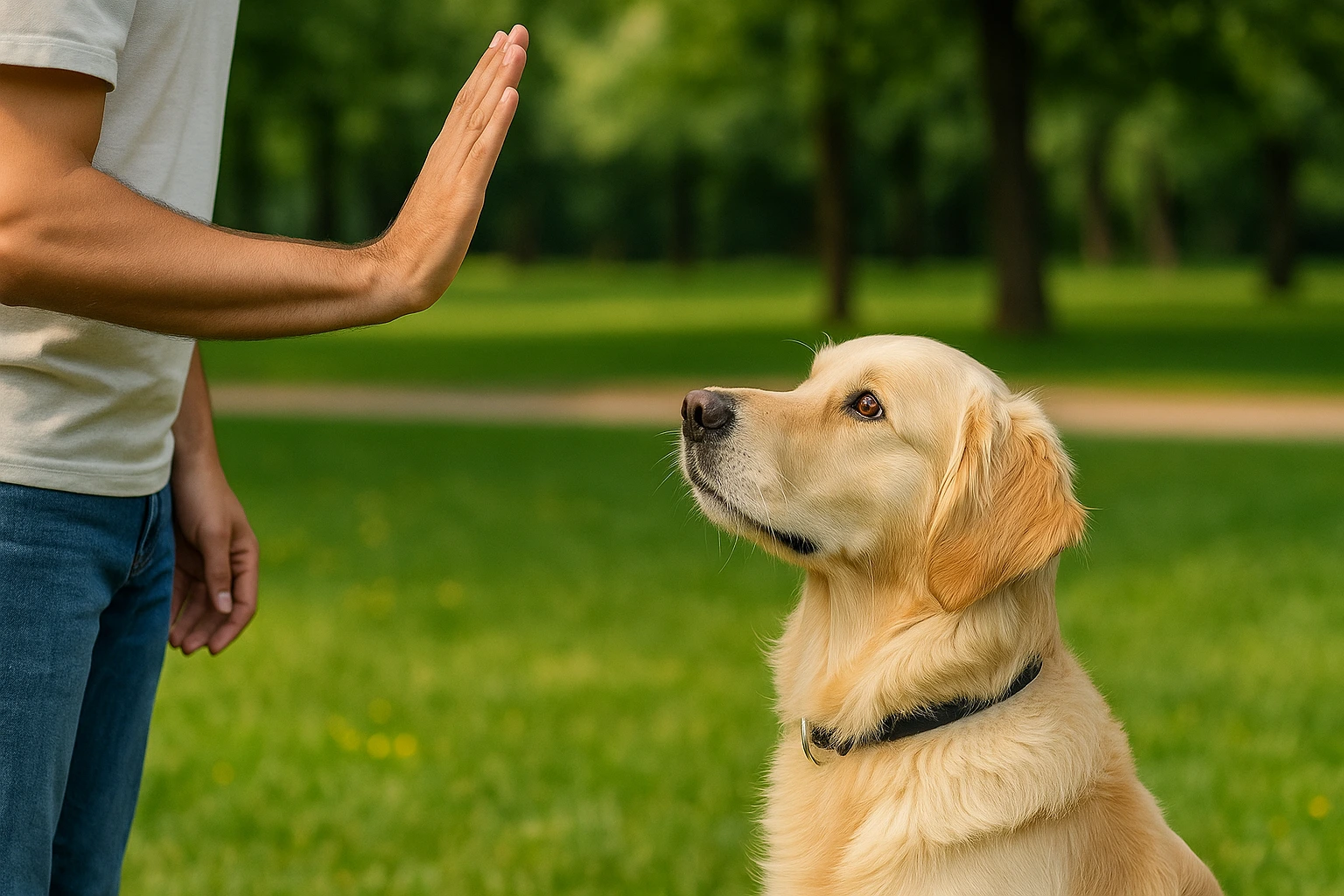Dog Training with Hand Signal
Dogs speak body language. While they may learn a few words, visual signals often speak louder—especially when training. Whether your dog is a young pup or a senior with hearing loss, using dog training hand signals can revolutionize the way you communicate.
In this guide, we’ll explore the benefits of hand signals, how to teach them, and a visual chart to get started. Let’s dive in!
Why Use Dog Training Hand Signals?

1. Perfect for Deaf or Senior Dogs
As dogs age, hearing loss is common. Hand signals allow you to continue effective training even if your dog goes deaf.
2. Better Communication in Noisy Environments
At a park, during a hike, or near traffic—verbal commands can get lost. Hand signals cut through the noise.
3. Dogs Read Body Language Better
A study from Animal Cognition revealed dogs respond with 99% accuracy to hand signals, compared to 82% for verbal commands. When the two conflict, they follow hand signals 70% of the time.
4. Mentally Stimulating
Training with hand signals engages your dog’s mind, boosts focus, and builds a stronger bond.
How to Teach Your Dog Hand Signals
-
Start with Eye Contact
Get your dog’s attention before signaling. Use two fingers in a “V” pointing to your eyes to build this cue. -
Use Positive Reinforcement
Reward correct responses with treats or praise. Never scold—just redirect. -
Pair with Verbal Cues (Initially)
If your dog hears well, say the command as you show the signal. -
Practice in Quiet, Then Distracting Environments
Begin indoors, then gradually move to busier places. -
Repeat, Reward, Repeat
Repetition locks in learning. Keep sessions short and fun.
🐶 Common Dog Training Hand Signals
Here’s a quick-reference chart for essential commands:
| Command | Hand Signal Description |
|---|---|
| Eye Contact | Make a “V” with two fingers and point to your eyes |
| Come | Palm up, curl fingers toward your chest (or bring hand across to opposite shoulder) |
| Sit | Palm up, bend elbow to raise hand to shoulder |
| Lie Down | Open palm or finger pointing down to the ground |
| Stand | Hand in front of dog’s nose, move it straight out |
| Stay | Palm out in a “stop” position |
| Drop It | Closed fist pointing down, open quickly like dropping an object |
| Leave It | Both hands open, palms in, move hands up and down |
| Yes | Fist nodding up and down |
| No | Wag index finger or flick it downward once |
| Quiet | Finger to lips (shushing gesture) |
| Walk/Outside | Fists circling each other |
| Heel | Tap hip or circle fist near your hip |
| Free/All Done | Swipe one open palm over the other (wrist to fingertips) |
FAQ For Dog Training Hand Signals
-
Can dogs be trained with hand signals?
Absolutely! Dogs often understand gestures better than words. Even hearing dogs benefit from hand signals in noisy areas or at a distance. -
What is the 3 3 3 rule for dog training?
While not directly about hand signals, this rule helps set expectations:-
3 days to decompress
-
3 weeks to learn the routine
-
3 months to feel truly at home
Use hand signals throughout this period to build trust.
-
-
What is the hand signal for come dog training?
The most common “come” signal is curling your fingers toward your chest or sweeping your arm to your opposite shoulder. -
When training a dog, what is the hand signal for sit?
Raise your open palm upward toward your shoulder in a smooth arc.
🐕 Pro Tips for Success
-
Be Consistent – Don’t change signals mid-training. Stick to one gesture per command.
-
Use Visual Cues Early – Even with puppies, pairing signals with words builds future flexibility.
-
Avoid Overwhelm – Teach one signal at a time. Let your dog master it before moving to the next.
-
Practice Daily – Short, 5-minute sessions each day yield better results than long, infrequent ones.
-
Use Treats Smartly – Slowly reduce treat frequency as your dog responds consistently.
🔁 Advanced Signals & Fun Tricks
Once your dog nails the basics, you can explore fun and useful extras:
-
Spin in a circle (spiral hand motion)
-
Fetch (point then motion forward)
-
Roll over (circle hand horizontally)
-
High five (palm up, forward)
-
Go to crate or bed (point to spot)
-
Good Job (thumbs up!)
🧠 Final Thoughts: Why Every Dog Should Learn Hand Signals
Training your dog with hand signals isn’t just a workaround for deafness—it’s a smart way to deepen your communication and strengthen your bond.
Whether your pup is full of youthful energy or a wise old soul, hand signals offer clarity, calm, and connection. Plus, they’re fun to learn together.
So, grab some treats, cue up that “come” signal, and start your visual training journey today!

